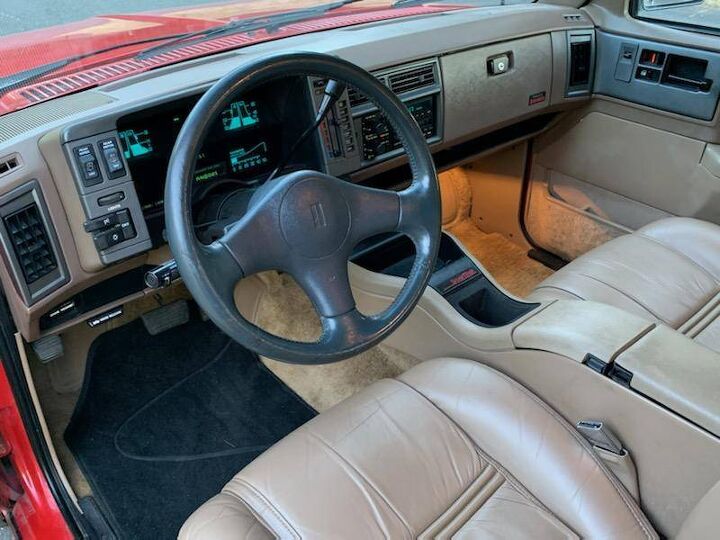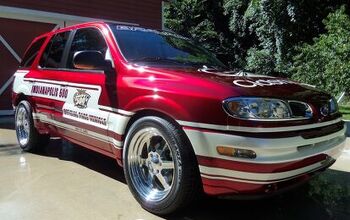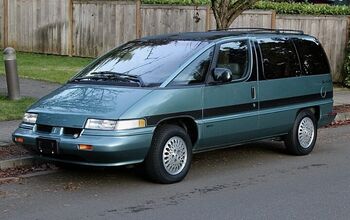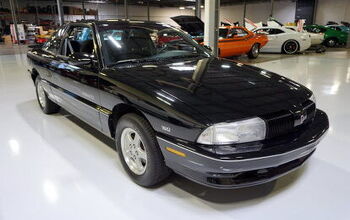Rare Rides: The Most Excellent 1992 Oldsmobile Bravada

Today’s Rare Ride represents a landmark for the Oldsmobile brand and a somewhat unsuccessful luxury badge experiment for General Motors.
Let’s check out the rarely seen first-generation Oldsmobile Bravada.
Rare Rides featured a Bravada way back in 2017 when this series was a spring chicken. But that Indianapolis 500 pace car was far removed from the Bravada’s genesis seen here.
By the time the Bravada entered production, the GMT330 platform was no spring chicken. The founding fathers Chevrolet Blazer and GMC Jimmy arrived for the 1983 model year, entrants into the new compact SUV class. For the first few years, all examples were two-doors, but American consumers cried out “More doors equals more sales.”
General Motors complied in the spring of 1990, when new four-door variants were introduced as model year ’91s. Wheelbase increased 7 inches (to 107), and made the four-doors almost 7 inches longer overall (at 176.8 inches) than the two-door counterparts. Still, the Blazer and Jimmy weren’t quite luxury vehicles.
The luxury SUV market was slim pickings in the early Nineties, with options limited to larger trucks like the Range Rover and Grand Wagoneer. But GM thought there was a place in the market for a luxurious compact as well. So Bravada was born.
This first-ever SUV to wear the Oldsmobile badge (and its first truck-based vehicle since the Twenties) arrived later in 1990, also as a model-year ’91. Designed only for U.S consumption and only as a four-door, Bravada had many more standard features than the Blazer or Jimmy. The exterior was differentiated by sleeker front and rear treatments that were more integrated than GM’s lesser choices. Bravada received a unique turbine alloy wheel design, and its own side trim. The overall look was monochromatic upscale, and two-tone was not offered in this generation. Inside leather was standard, as were digital gauges and an exclusive swoopy center console.
Fitting the mission, only the GMT330’s largest engine was available in the Bravada: the 4.3-liter Vortec V6. For 1991 Bravada used old throttle body injection, but switched to electronic fuel injection in 1992. Engine refinements brought 1991’s 160 horsepower up to 200 in 1992. All Bravadas had a four-speed automatic and had an exclusive drive train via SmartTrak. An all-wheel-drive system, it was full-time and automatic. The system used a transfer case by Borg-Warner. It was shared with the Astro and Safari vans, as well as the special GMC Typhoon.
GM made changes over the Bravada’s run to further differentiate it from its siblings. Aside from the engine upgrade in 1992, the instruments were revised the same year. In 1993, an overhead console with digital display arrived, and so did the excellent Gold Package. Additions in gold were an exterior pinstripe, badges, and gold turbine alloys. By then, all three GMT330s were due for a refresh. Blazer and Jimmy were reworked for ’95, but slow-selling Bravada had to wait a year. It appeared wearing new (and arguably less distinguished) clothes for model-year ’95.
Today’s Rare Ride is in great condition, in excellent sporty red over tan. It might need a bit of cleanup, and is yours for $3,495 in Portland.
[Images: seller]

Interested in lots of cars and their various historical contexts. Started writing articles for TTAC in late 2016, when my first posts were QOTDs. From there I started a few new series like Rare Rides, Buy/Drive/Burn, Abandoned History, and most recently Rare Rides Icons. Operating from a home base in Cincinnati, Ohio, a relative auto journalist dead zone. Many of my articles are prompted by something I'll see on social media that sparks my interest and causes me to research. Finding articles and information from the early days of the internet and beyond that covers the little details lost to time: trim packages, color and wheel choices, interior fabrics. Beyond those, I'm fascinated by automotive industry experiments, both failures and successes. Lately I've taken an interest in AI, and generating "what if" type images for car models long dead. Reincarnating a modern Toyota Paseo, Lincoln Mark IX, or Isuzu Trooper through a text prompt is fun. Fun to post them on Twitter too, and watch people overreact. To that end, the social media I use most is Twitter, @CoreyLewis86. I also contribute pieces for Forbes Wheels and Forbes Home.
More by Corey Lewis
Latest Car Reviews
Read moreLatest Product Reviews
Read moreRecent Comments
- Spectator Wild to me the US sent like $100B overseas for other peoples wars while we clammer over .1% of that money being used to promote EVs in our country.
- Spectator got a pic of that 27 inch screen? That sounds massive!
- MaintenanceCosts "And with ANY car, always budget for maintenance."The question is whether you have to budget a thousand bucks (or euro) a year, or a quarter of your income.
- FreedMike The NASCAR race was a dandy. That finish…
- EBFlex It’s ironic that the typical low IQ big government simps are all over this yet we’re completely silent when oil companies took massive losses during Covid. Funny how that’s fine but profits aren’t. These people have no idea how business works.








































Comments
Join the conversation
My parents bought one of these off a local company that had it as a former company car which got put in their back lot and forgotten for a couple years. They got it for a steal. It was like 5 years old, had only about 15,000 miles and I think they got it for 5K. The company just wanted to get rid of it. It was fully loaded black on black. It needed new tires, and a good cleaning and that was about it. It was the family's "extra" car. But at the time, it was the only SUV in the family so it proved useful. It ended up becoming by default the car my younger brother "drove" and took away to college (but my parents still called "theirs"). We took it on many ski trips, it was great in the snow and reasonably comfortable and largely trouble free for several years. That digital dash made it seem fairly techy. Sadly was totaled when it was hit by a drunk driver while parked, probably with lots of life left in it. My brother replaced it with a Mercury Mountaineer.
At old GM I worked with a guy who was an engineer *and* a beancounter and had a brand-new one of these. He and his spouse were out with another couple (because 4 doors) and stopped at a light when somehow another vehicle ended up coming toward them in their lane. He quickly put the Bravada up on the sidewalk (because SmartTrak) and quickly stopped before slamming into anything (because ABS). He was very pleased, and his friends were impressed.